This is my first attempt at writing up a trip report – so please excuse clumsy layout and poor quality photos (all taken with phones).
We’d loosely planned a week in France Sunday 26th May to Saturday 1st June but ended up departing a day early because the weather on Sunday 26th was forecast to be fairly poor.
So, after lunch on Saturday (gardening done, dog dropped off at his home from home) we bundled into the car and down to White Waltham (EGLM) to get G-OFIT, the TB10 in which I have a share, ready for our first leg to La Rochelle.
Refuelling at White Waltham prior to departure:
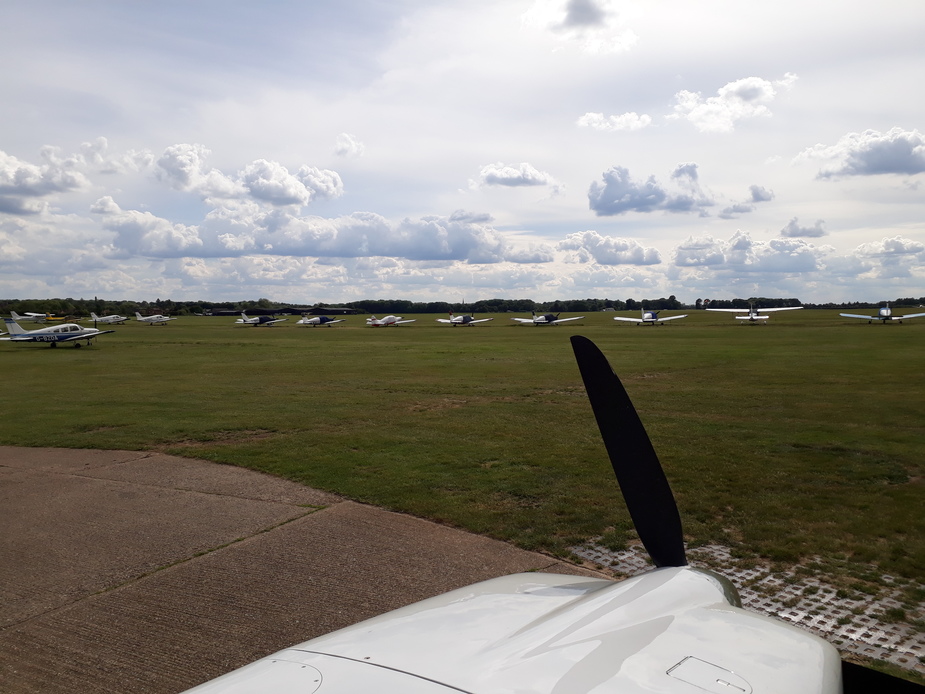
We filed a VFR flightplan, EGLM VAPID BEGTO MARKU VAKSI BOBRI LFBH. 324nm in total and estimated at about 2 hours 45 minutes with a gentle tailwind.
Departed Waltham, and after VAPID we had the usual fun and games with the gliders at Lasham and valiant attempts from Farnborough Radar to tell us where they all were. When crossing the channel out of White Waltham I normally go this way (i.e. west a bit first, north of Odiham rather than south of it) because it allows one to get up a bit higher a bit sooner as the London TMA rises a bit more rapidly out to the west. If you go straight south you are stuck at fairly low level (below 3.500 feet) for somewhat longer.
Continuing south Solent Radar were very busy and we almost didn’t get a transit in time. I was just turning away from the boundary when he came back to me with a clearance, and shortly afterwards he laughed at the next guy to call up and told him he was number six in line for a callback and no service was available.
Leaving Solent’s airspace and the CTA continues to step up so we continued the climb to cross the channel at FL70. Most of the Cherbourg peninsula and all of the Channel Islands were shrouded in very low (overcast) cloud and fog. The tops could not have been any higher than 500 feet, so the engine-out options were really poor in this area. One would probably have to have turned back out to sea where at least the surface could be seen, or try and drop onto the runway at Cherbourg using the GPS.
Bournemouth were able to give us a radar service as far as the FIR boundary and helpfully established for us that Danger Area 36 was inactive – it usually always is at weekends. Bournemouth are happy to work you further south than many UK pilots think (a few weeks ago they handed me straight to Jersey Control) so between them and Western Radar (in theory you need to be above FL70) there is better coverage than many people think. I am very keen on having a radar service all the way across if possible, and of course once you’re with Brest you’re into the seamless and integrated French system.
Heading into northern France the really low stuff cleared up and it was the forecast scattered at 4,000 feet with the tops stretching up to about 6,000 feet.
There’s not a huge amount to see when crossing France like this. Endless fields, the odd autoroute and town. We piped some relaxing music into the intercom and settled down for a smooth ride south.
Further south and the cloud thickened up, more like broken although still with plenty of holes to get down (with only an IR(R) I am restricted to VFR outside the UK) and the tops were getting up towards us. We skimmed along the top of some pretty clouds and then the ones ahead were higher than us so we asked for another thousand feet which was no problem at all.
Before the cloud thickened up:
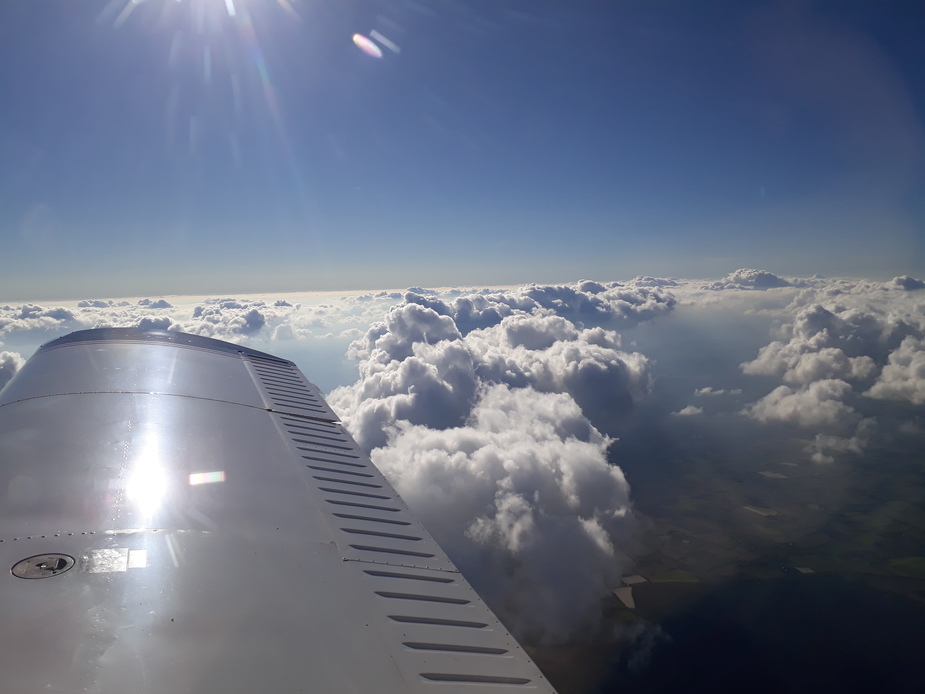
French ATC was completely seamless. Brest Info took our details when we called them approaching the FIR boundary. They handed us to Rennes North, who handed us to Rennes South, who handed us to Nantes, who handed us to La Rochelle. All easy, straightforward and exactly how it should be. No telling your life story each time, just give your callsign and receive the reply “radar contact” and a new squawk to set. We went through TMAs at Rennes and Nantes, but one would hardly know it.
We heard a couple of other light aircraft on frequency, some French and one British which was quite embarassing to hear. He was giving some unnecessarily detailed description of his route to a very patient Brest Info and then topped it off by requesting a basic service. We shook our heads. Mostly though it was just a few airliners on frequency – the odd Ryanair, Easyjet and a Lufthansa departing Rennes and Nantes.
Approaching La Rochelle the cloud thinned right out and with about 30-35NM to run it was no problem at all to find a clear way down and begin our descent. Amanda’s ears are quite sensitive so we plan things to avoid descending at any more than 500 feet per minute. She works the numbers and tells me when we reach top-of-descent – her remit is expanding to include more pilot-like duties, which (hopefully!) keep her interested. She already does the fuel log (tank gauges are useless and no flow meter fitted), does a manual PLOG as a backup to the GPS and sets up the next frequencies for me.
Until relatively recently my fuel management strategy in G-OFIT had been somewhat vague and imprecise. What I tended to do was just make sure the total fuel on board was easily enough for the flight (say at least 2hrs fuel on landing) and then change tank every 30 minutes. It was fairly safe but it was imprecise and without racking my brain I could never say at any given point in the flight how much was in each tank. In the event of a weather (or other) problem that required significant holding or a significant diversion it could have become interesting as I wondered exactly how my last hour of fuel was distributed between the two tanks. I also tended to end up with some sort of imbalance a lot of the time with the aeroplane pulling to one side or other – and the TB10 does not have aileron or rudder trim in the cockpit.
This trip was the first significant trial of a little system that Amanda and I developed together. It is very simple (I like simple) and very easy. It can be done on any scrap of paper or in the corner of a plog or an approach plate or wherever. We just draw a little table with two columns and ten rows. The columns are the tanks (left and right) and each row represents 10 litres of fuel tank space. The numbers are very handy because the TB10 holds 100 litres each side (actually 102 useable but forget the 2 and the error is on the safe side). The consumption is also easy to plan, because the ‘safe’ planning number I use is 40 litres an hour. The POH gives 38.6 litres an hour (6000 feet, ISA, 73% BHP and leaned for best power) but again 40 litres per hour is a small error on the safe side and makes the numbers very easy. Thus each row in our table represents 15 minutes of fuel.
Prior to departure I check the tanks (the TB10 has a very good numbered scale inside each tank showing 30 litre, 60 litre and 85 litre markings that it are very easy to interpolate between) and Amanda strikes through the upper rows of the little table to account for fuel that we don’t have on board at departure. So if we start with 60 litres in the left and 80 litres in the right (it is a group aircraft with a ’don’t refuel’ policy – so starting with an imbalance is common) then she just strikes out the first four rows in the left column and the first two rows in the right.
We take off, switch tank every 15 minutes (the first switch is after 10 minutes to account for greater burn on takeoff and climbout) and each time I switch Amanda strikes off each ‘block’ of fuel as having been used. Thus we always have a good visual indication of the fuel on board. She uses the elapsed time function on the ADF (may as well use it for something!) to let me know when a change is due – when it’s due I assess the balance of the aircraft in roll and decide whether to change or pull a ‘double shift’ on the current tank. She updates the table accordingly.
It worked very well on this trip, was very easy, and I found that imbalances in roll were much less frequent than they had been in the past – with a corresponding improvement in heading-keeping. Each time we landed we checked the tanks and they showed pretty much exactly the amount of fuel that our table said they should – though we always had very slightly more in the tanks than on the table because of the conservative consumption number used. I like a small and consistent error in this direction. Of course I can easily do it all myself, but when you fly with a partner I think it is nice to have them involved. It is also helpful because I’m prone to the odd bout of reverse-logic, such as when I decide out loud that it’s pulling left so I should switch to the right: “No sweetie, if it’s pulling left you need to burn the left to even it out” comes the sage reply from the right-hand seat.
Back to the approach into La Rochelle, we’re given a continuous descent and positioning for a right base to runway 27. On go the snazzy sunglasses as the approach is right into the sun and I really can’t see very much, but the landing is fine and the view is beautiful – a lovely time of day to be arriving – just approaching 8pm local time.
Approaching La Rochelle:
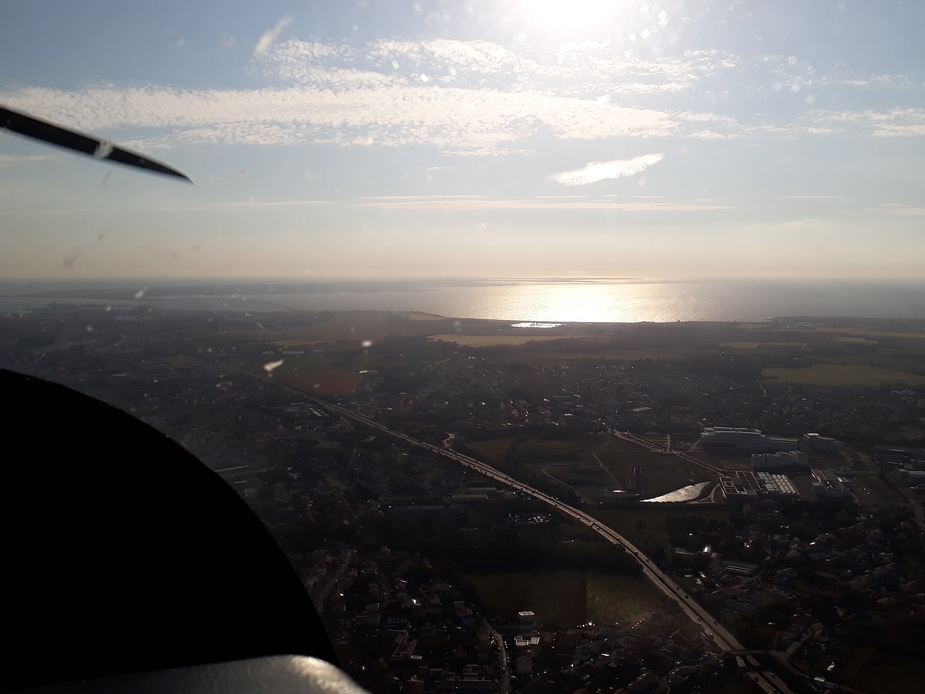
Parked up:

We ended up spending four nights in La Rochelle and it’s a very nice place. Plenty of good restaurants to choose from (even if we could never make a decision!) and on our last day we hired bikes and cycled over the bridge to the Ile de Re. Each morning we had coffee and croissants at a lovely old-fashioned cafe called the Cafe de la Paix. A bit of shopping (excellent place for clothes shopping) and plenty of old buildings to look around – something we both enjoy. We took a tour of the towers that guard the entrance to the harbour and saw prisoners’ graffiti going back to the 1600s. The maritime museum was good too, and we also saw what we thought might be a Banksy.
La Rochelle:
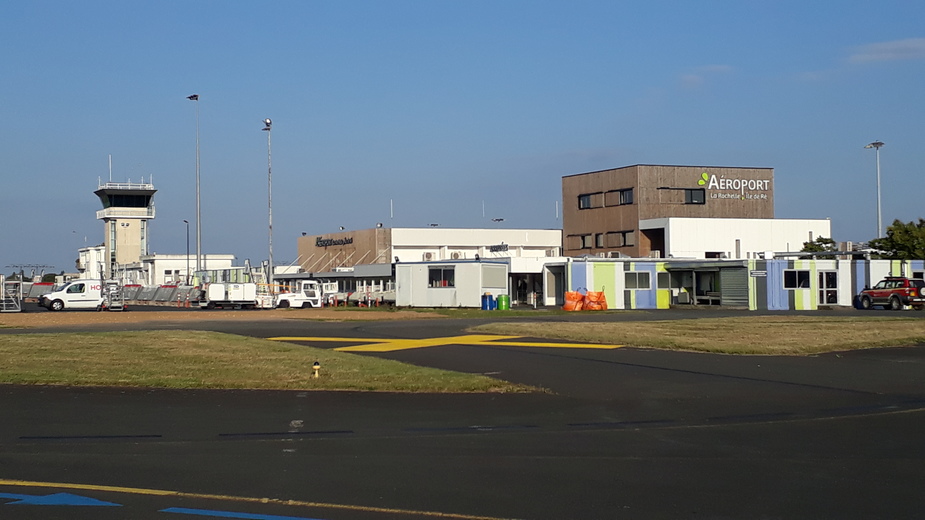


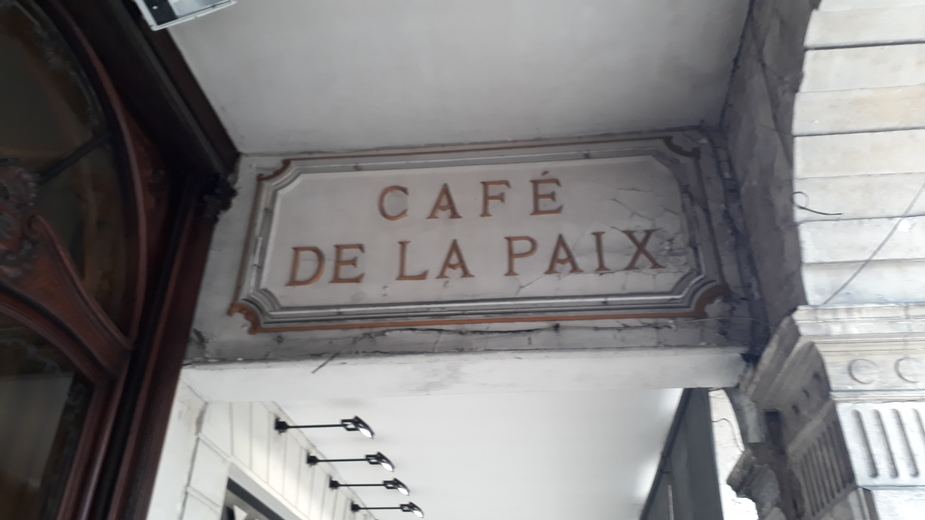
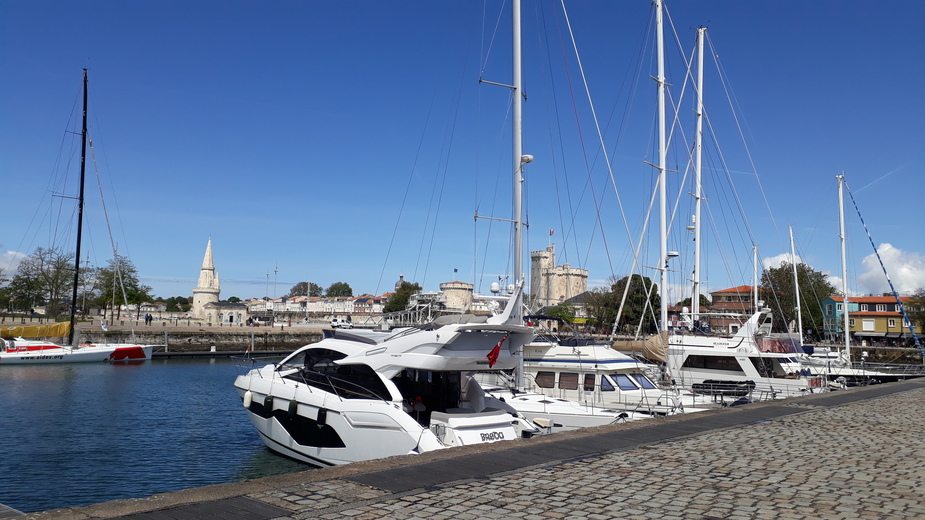
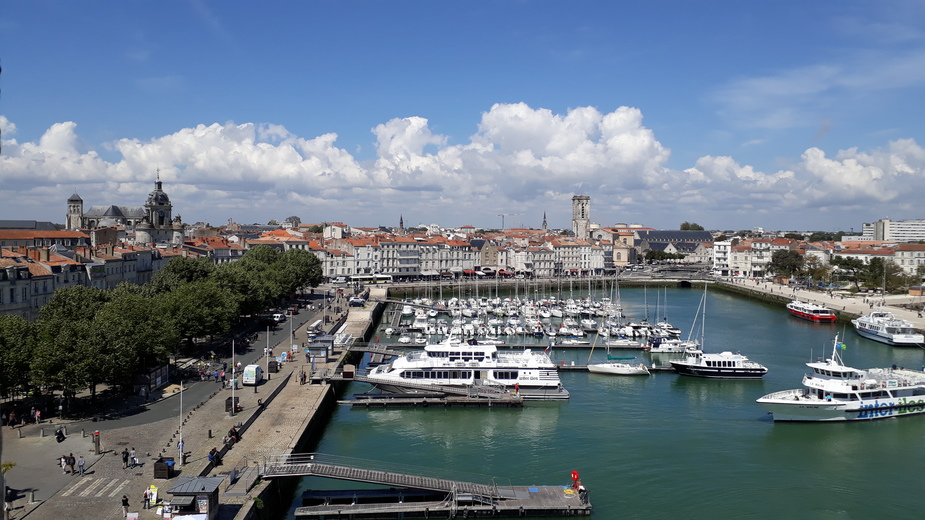

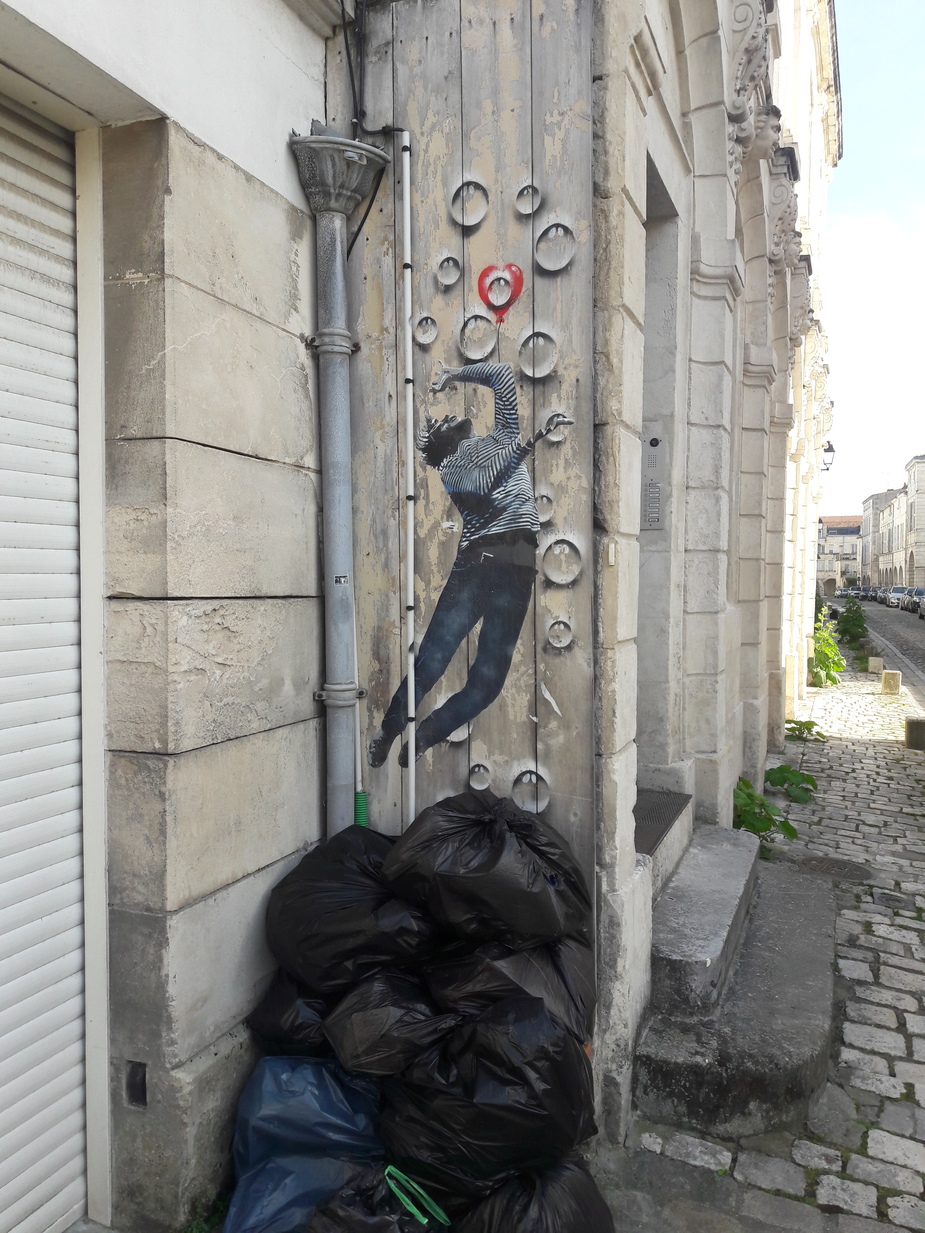
Departing La Rochelle one day later than planned, we choose to move on to Tours rather than the initially-planned Quimper. The weather inland had improved substantially but further north on the atlantic coast there was a lot of low cloud – Quimper had Metars and TAFs full of OVC005 and other non-VFR stuff.
As the sun set the night before you could feel that the air was becoming very fresh and it would be a clear night with a clear blue sky early the next morning. The temperature was forecast much higher than previous days up so it would get convective towards noon. It looked like a nice early start was the best plan for a smooth flight.
Taxi from the hotel at 8am local time with a plan to be airborne an hour later for a relatively short flight (123nm, a dead straight line) to Tours. Arriving at the airport we met two English chaps in a Mooney heading further south. Our wheels left the ground slightly before 9am local and as we expected the air was beautifully smooth and the visibility fantastic – a deep blue sky and severe CAVOK.
Departing La Rochelle:
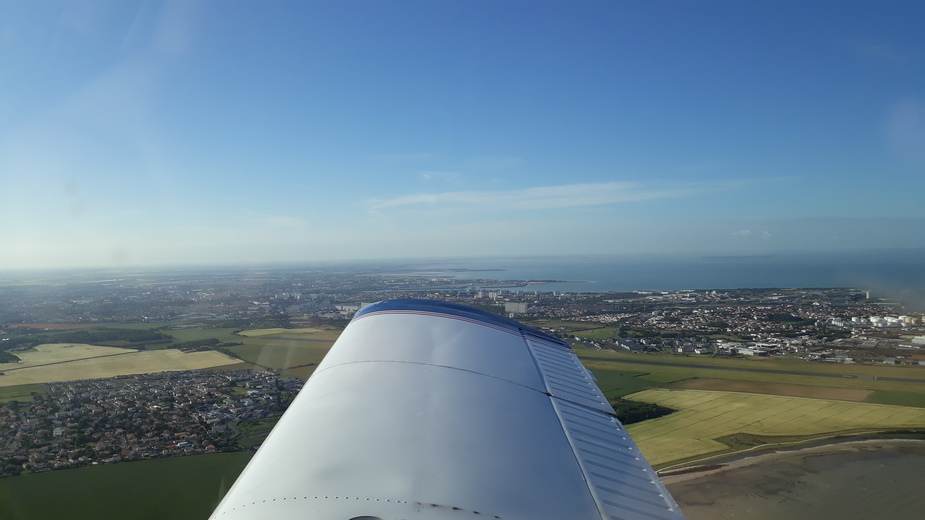
As we headed northeast at 5,000ft some scattered clouds started to appear very low down – bases at about 1,000ft and tops about 2,500ft. Approaching Tours this rapidly thickened up and it became necessary to descend through a hole in the cloud to maintain VFR – fortunately we were pretty much there by the time this was necessary. I am not keen on flying at very low level for any serious amount of time – it greatly limits the engine-out options and I am convinced that in an engine failure scenario a significant portion of the small time available before a forced landing would be lost to the startle factor. Apart from anything else it is often quite bumpy at low level, which passengers do not tend to like.
La Rochelle had coordinated with Congac to give us access to the military airspace en route and then handed us on to Poitiers who handed us on to Tours. This seamless system is brilliant and saves a lot of research work – I cannot imagine how tough it is for French pilots visiting the UK trying to work out who might be prepared to give them a radar service and where (not to mention when!).
I came off a direct track slightly to avoid a restricted area southwest of Tours and after our descent through the clouds we were asked to report west of the field. 02 was in use but long final was unavailable due to ‘circuit traffic’. Once due west of the field the controller asked us to pass overhead at 90 degrees to the runway and position ourselves to turn mid-downwind (right hand) for 02. As we came overhead he told us we were number two to an Alphajet on final approach doing circuits.
Any question as to whether we were number two to his current approach or his next one was soon answered.
The jet touched the runway almost beneath us and roared away to the north very briefly before pulling into a hard right turn for the upwind end of the oval-shaped military circuit. Once he’d turned through 180 degrees onto downwind it was quite a sight as he was basically coming right for us and getting quite big in the left hand window! But our easterly course took us across his path and he shot behind us – we had to do the Top Gun bit – so I said to Amanda “where’d he go?” and Amanda shouted back “where’d who go??!!!”
That excitement over with, the controller said you can turn downwind now so we slotted in behind him. He’d made that last one a full-stop so we assumed that was the end of our show for the day.
As we taxied in we were passed to a ground frequency – a first time for me. A little bit of confusion on where to park because I couldn’t understand the heavily-accented pronunciation of ‘chopper’ (think ‘shoppeeerrrr’) but we were soon parked up next to a helicopter maintenance outfit and unloading our bags. One of the buildings next to this outfit appeared to be an indoor shooting range with a steady crackle of pistol fire emanating from it.
Suddenly three more Alphajets arrived in the overhead and flew down the runway to run-and-break in succession. They each did a touch and go and then landed to taxi up to the military apron at the other end. A minute or two passed and then two more arrived and did the same. It seems Tours is mainly a military airfield with a history going back to the First World War, but became open to civil use in the 1960s.
Then two blokes in military kit started poking around in the very long grass behind the apron we were parked on. We watched them for a short while trying to establish what on earth they might be doing, but then went back to putting the cover on G-OFIT. Aeroplane covered and we heard two (very loud and obviously close) gunshots, clearly from the area these blokes had been in. We looked round and couldn’t see them any more. Oh well.
Short final at Tours:
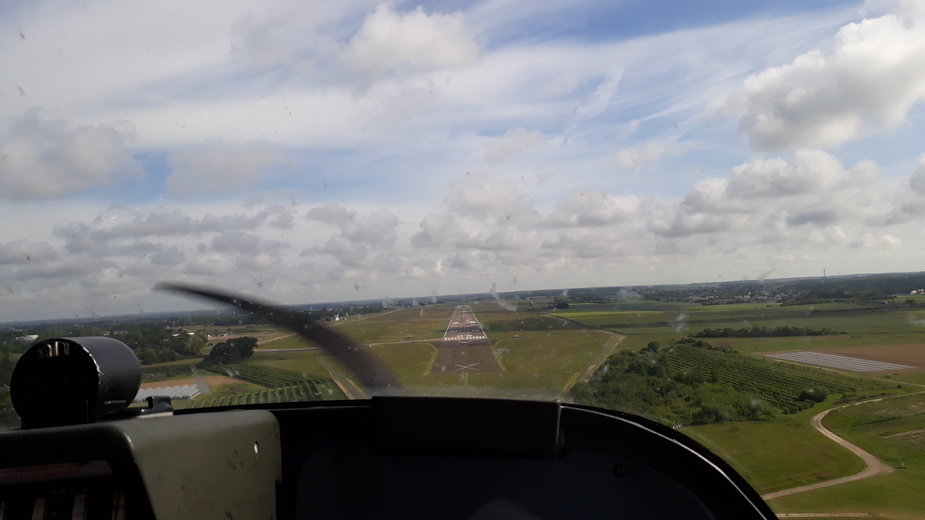
An Alphajet doing a touch-and-go (small speck right-of-centre, slightly more than halfway up the picture):

Tours is a nice city and we got a nice hotel, but two nights there was enough for us. We had planned on only one night and then two in Jersey, but poor weather in Jersey (all of that area socked in with low cloud and fog) kept us in Tours until the Friday morning.
Tours cathedral, the river Loire, Hotel de Ville, the railway station and our nice hotel, plus a big snail in the botanical gardens:
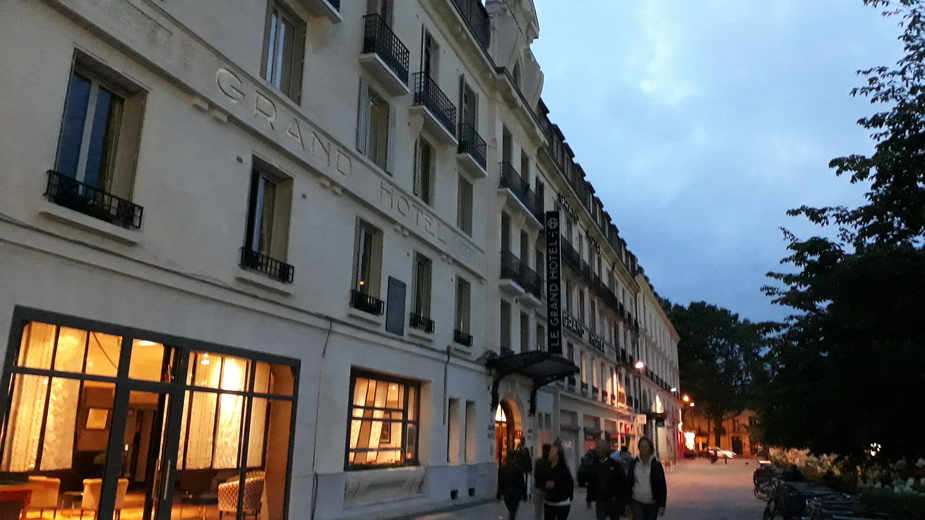
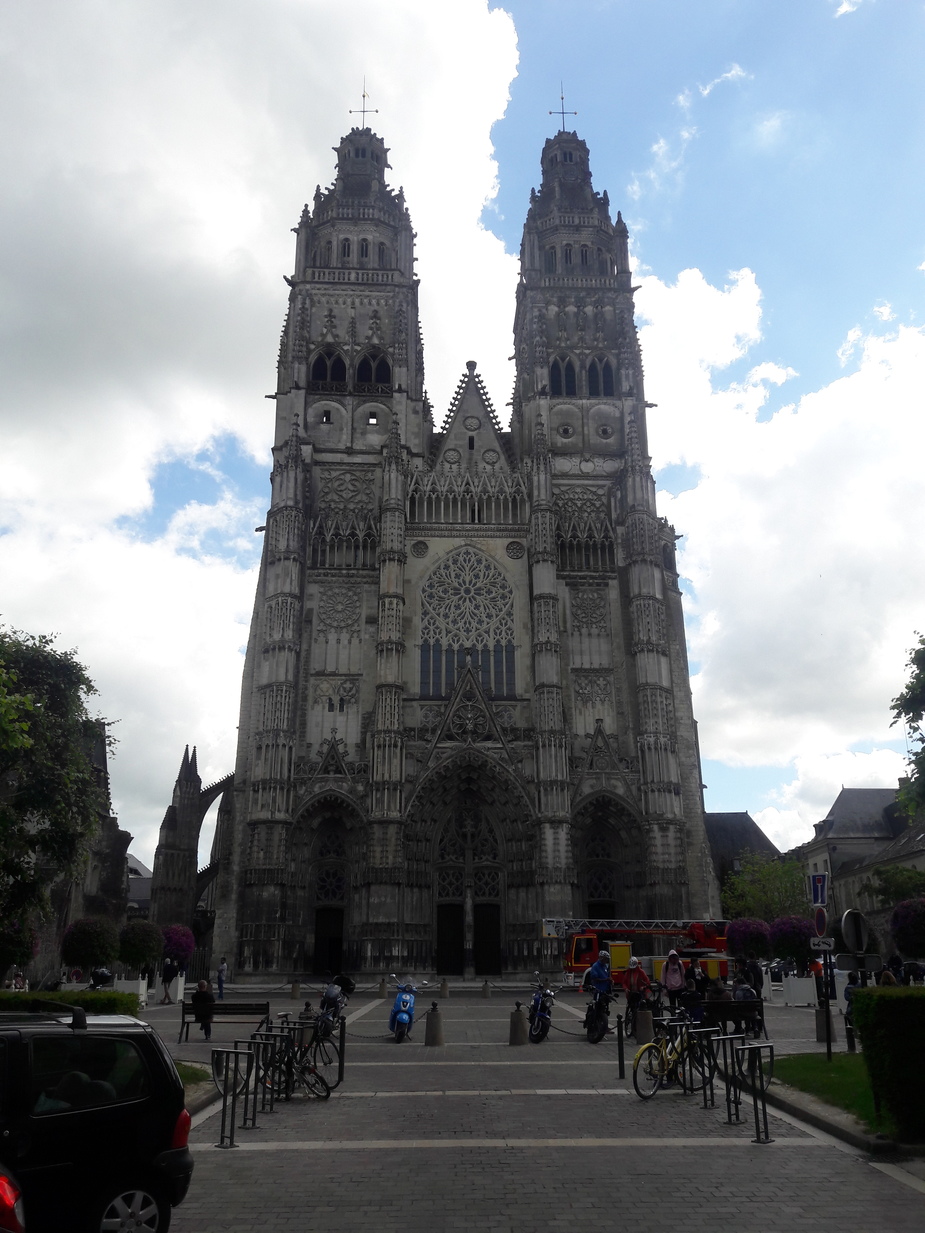
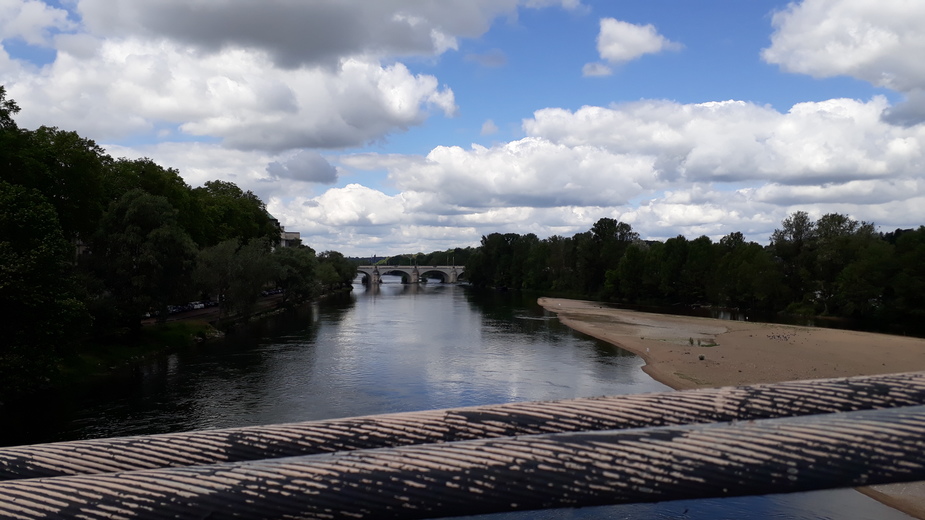
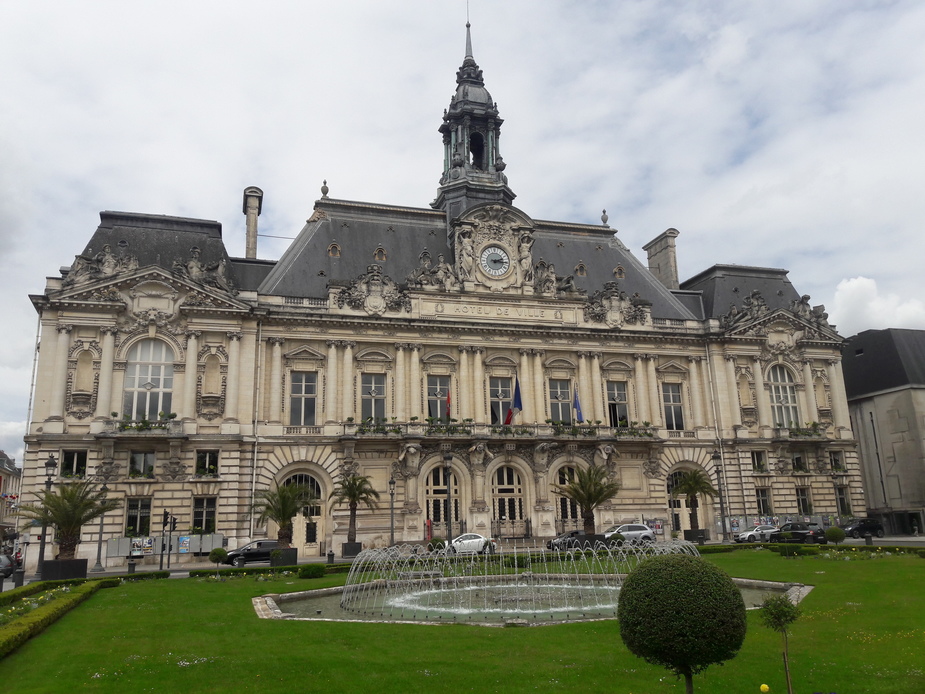
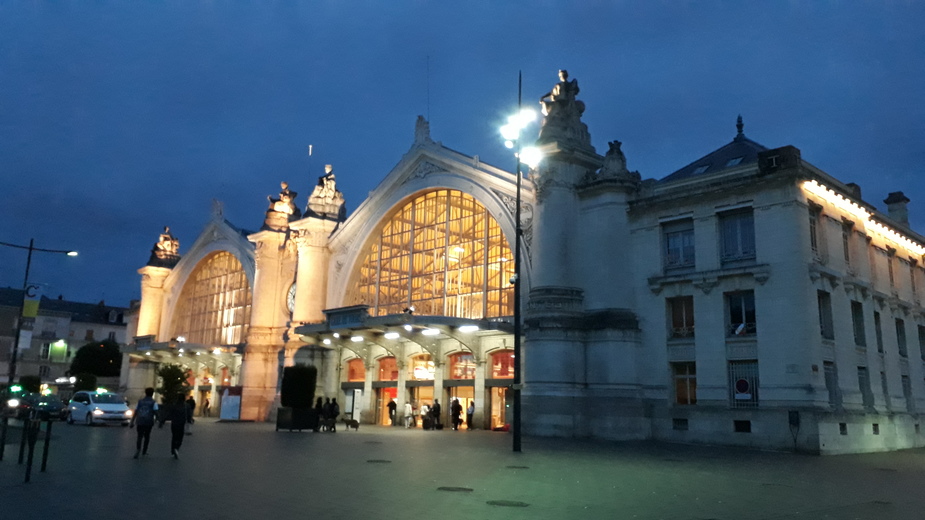

Arriving at Tours airport on Friday morning we had to wait around a bit for the man to come and open up. Then there was an interesting experience where we presented with an unexpected bill for 130 EUR. This was argued over for some time, eventually paid very reluctantly just to get out of there, and then at the last minute before going airside I noticed that the bill wasn’t actually ours – it was for a Swiss helicopter! Poor attention to detail on my part, not checking the invoice thoroughly. They claimed not to be able to refund my card, so I left with the email details of the airport manager. They have since been in touch and will be wiring me the money back, and as a gesture of goodwill for all the hassle have waived our bill completely. Landing and 2 nights parking should have been around 30 EUR, we understand.
There was a group of three British pilots there in a PA28 rented from Freedom Aviation at Kemble (EGBP). We walked out airside together and wanted to be off at about the same time. Strangely there was no-one in the tower and no answer on any of the published frequencies when we called for start, despite being within the published ATS hours. We discussed the situation with the guys in the PA28 over the RT and the consensus was that it was best to get airborne before someone came running out from the office to tell us the airport was actually closed.
Off we went and called up Nantes on the radio to get our flight plan to Jersey activated.
A gentle cruise at 5,000 feet direct to Jersey (no point going higher as had a slight headwind) and we were soon handed over to Jersey Control, cleared into the zone IFR to expect vectors for the ILS.
This has become my default way to arrive at any of the Channel Islands – one might as well make use of the IR(R) entitlement to fly IFR in Class D and my experience is that it allows you to maintain higher altitudes over the sea (they like to keep VFR traffic low and out of the way) and seems to give you priority over VFR inbounds. There was a DA40 from Austria who arrived in the zone VFR just before us and he was kept out of our way and landed after us. We entered a layer on descending to the platform altitude of 2,000 feet but were visual at more than 1000 feet.
One night in a very nice hotel, a few very nice meals and a nice time riding bikes around the southern part of the island and it was time to head home with the tanks full of lovely tax-free avgas. Jersey Aero Club were very helpful as usual, although we had to keep calling ahead of time to check that they’d have parking space for us – an enormous flyout from Finland seemed to be in attendance and parking was in short supply. The grass was all cut and seemed to be in better condition than on previous visits.
ILS 26 at Jersey:
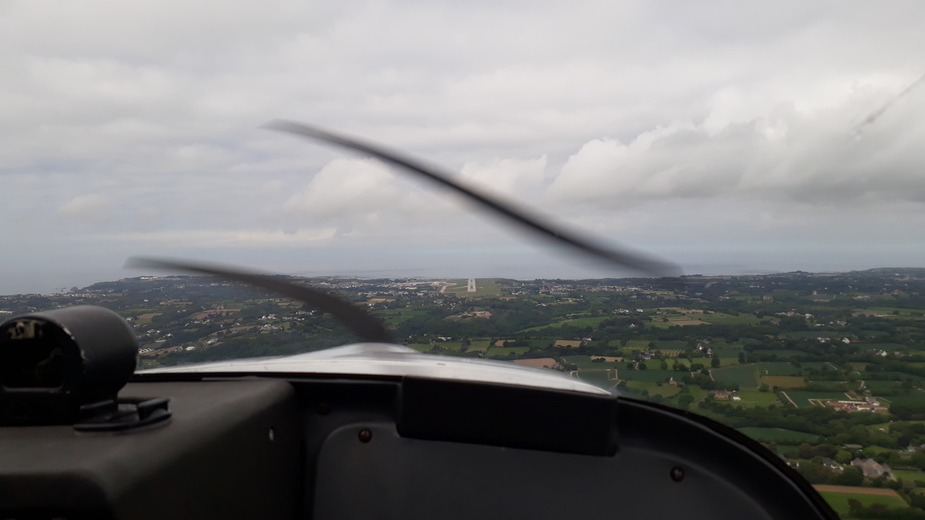
Beach at St. Aubin:
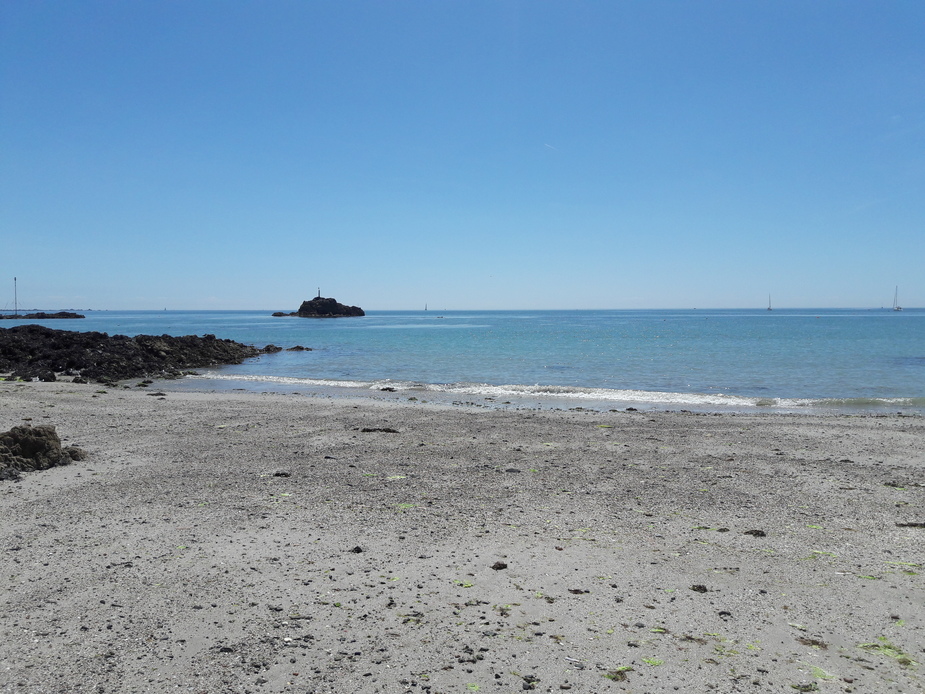
The wind had turned around and having crossed the channel southbound a week ago with a tailwind we were now crossing it northbound with a tailwind. I love it when this happens. Departing just before some para-dropping started, we were routed direct ORIST with an unrestricted climb to FL60 – better than our departure from Guernsey a few weeks back where they tried to keep us down low. Again we called up Bournemouth Radar who gave us a service from ORIST until we were up in Farnborough Radar territory. It is nice not to have to go to London Info when crossing the channel. It is clear that Bournemouth and Jersey’s areas of coverage do meet in the middle, but you have to make your own decisions and ask for what you want and not just follow the suggestion from Jersey to call London Info. Other options are Western Radar (minimum FL70 apparently) and Plymouth Military, although the latter does not work weekends.
An uneventful arrival at White Waltham and we were soon sat on the lawn sipping beers. Then drive home, fetch the dog, mow the lawn…. and back to work on Monday :-(
Graham
that was a great trip report with lots of interesting detail. Love your fuel management trick!
Great report – La Rochelle has a special place in my heart as I finished my PPL traing there.
Nice trip and thanks for your good report ! Great to know your partner enjoys flying !
Yes flying in the UK is awkward for a French… But in France, without FPL, you still need to tell your story to each controller and set a new code. I dream of the US FF …
Good point for the Channel radar services, that’s what we did between Jersey and Exeter when we flew to Newquay and Scilly.
And yes, if nobody answers on the radio, you can depart ‘blind’ in France. You just pick your runway and go. I guess it seems strange for UK and German flyers.
Edit : did you take fuel in La Rochelle ? I read the pumps are now WFS instead of BP. I am curious to know how it works with this fuel supplier.
Great report and pics; thank you for posting it 
one British which was quite embarassing to hear. He was giving some unnecessarily detailed description of his route to a very patient Brest Info and then topped it off by requesting a basic service. We shook our heads
This is pretty normal, and often embarrassing. It is PPL training, however, and it is roughly the same everywhere… UK PPLs are also usually trained to talk too much on the radio. However I think most countries’ PPLs make fools of themselves when they go abroad the first time; the vast majority of them never do, for various reasons.
Amanda’s ears are quite sensitive so we plan things to avoid descending at any more than 500 feet per minute. She works the numbers and tells me when we reach top-of-descent – her remit is expanding to include more pilot-like duties, which (hopefully!) keep her interested. She already does the fuel log (tank gauges are useless and no flow meter fitted), does a manual PLOG as a backup to the GPS and sets up the next frequencies for me.
You are unusually fortunately to have your GF/wife flying with you 
I cannot imagine how tough it is for French pilots visiting the UK trying to work out who might be prepared to give them a radar service and where (not to mention when!).
For a simple life, one flies in Class G, silently 
This is harder to do in France because a lot of the airspace there is difficult to work out from the map, and it works because ATC just clear one through (usually).
La Rochelle is indeed a super destination. We did a little meet-up there about a year ago.
Jujupilote wrote:
Edit : did you take fuel in La Rochelle ? I read the pumps are now WFS instead of BP. I am curious to know how it works with this fuel supplier.
Yes Juju, we took fuel. They have a brand new self-serve setup with a new ‘pit-lane’ fuel bay on a new piece of tarmac taxiway. Kind of like a loop, one way in and one way out – which we managed to go the wrong way into and then did a 180! The machine takes any credit card, although it is a bit temperamental and the man in the kiosk had to come out and strike it very roughly before it worked for us. The machine will time out if you don;t start dispensing fuel quickly so make sure you put the grounding line onto the aeroplane and run the fuel hose out as far as you need before you play with the credit card machine.
Brilliant working Life of Brian into Euroga:)
Enjoyed the report, although the fellow Brit on RT may have been in English in foreign land mode?
Very nice report !